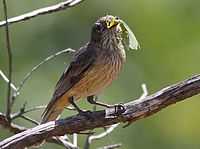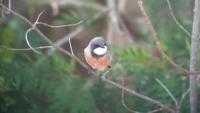Rufous whistler
| Rufous whistler | |
|---|---|
 | |
| Male | |
| Conservation status | |
| Scientific classification | |
| Kingdom: | Animalia |
| Phylum: | Chordata |
| Class: | Aves |
| Order: | Passeriformes |
| Family: | Pachycephalidae |
| Genus: | Pachycephala |
| Species: | P. rufiventris |
| Binomial name | |
| Pachycephala rufiventris (Latham, 1802) | |
The rufous whistler (Pachycephala rufiventris) is a species of whistler found in New Caledonia, Papua New Guinea, and throughout Australia (with the exception of Tasmania). Predominantly a reddish-brown and grey bird, it makes up for its subdued plumage with its song-making ability. Like many other members of the Pachycephalidae, it has a variety of musical calls.
Taxonomy
It was originally described as Sylvia rufiventris by the English ornithologist John Latham in 1802,[2] and later considered a member of Laniarius before being described in the genus Pachycephala.
Description

Rufous whistlers are large-headed and stocky. They have short beaks and long tails (almost as long as the rest of the bird) which are very narrow and have sharp, forked tips. The species is sexually dimorphic. While females are typically dull brown or grey with streaked underbodies, males are predominantly dark-grey with white throats and (in most cases) a black mask that covers most of their head and some of their neck. These birds are between 16 and 18 centimetres in size, on average, and their average weight is approximately 25 grams.
The rufous whistler has a variety of musical calls which consist of a lengthy series of ringing notes.
Habitat
The rufous whistler can be found in forested areas, woodland and shrubland, but also in gardens and farmland. It migrates seasonally, moving south in the spring and north in the autumn. In New Caledonia the species does not undertake migrations but is instead resident in areas of open forest and savannah.
Feeding
While rufous whistlers primarily feed on insects, they also eat seeds, fruit and occasionally, leaves and grasses. They never forage for food on the ground which is unusual for whistlers which typically do not forage at particularly high levels.
Breeding
Breeding in monogamous pairs, both males and females incubate their eggs and care for their young. The period of incubation is about 13 days on average. The female alone constructs the nest, which usually consists of a combination of twigs, vines, grass and other matter formed in a cup-like shape and attached to a tree branch using strands from spider webs. The breeding season for rufous whistlers is between the months of July and February.
-

Female eating a praying mantis
-

A juvenile male at Kobble Creek, south east Queensland, Australia
-
Young male, south east Queensland, Australia
References
- ↑ BirdLife International (2012). "Pachycephala rufiventris". IUCN Red List of Threatened Species. Version 2013.2. International Union for Conservation of Nature. Retrieved 26 November 2013.
- ↑ Latham, J. (1802). Supplementum Indicis Ornithologici, sive Systematis Ornithologiae. London: G. Leigh, J. & S. Sotheby 74 pp. [54]
- Clements, James F. (2000). Birds of the World: a Checklist. Cornell University Press. p. 880. ISBN 0-934797-16-1.
External links
- Basic information - Birds in Backyards
- www.birdphotos.com.au
- www.jcu.edu.au
| Wikimedia Commons has media related to Pachycephala rufiventris. |
| Wikispecies has information related to: Pachycephala rufiventris |

